The Trials of A Champion - F1 Fitness Regime
We subject our test driver to the same physical aptitude tests that are conducted on Ferrari F1 drivers. So, what did we find out? Maranello is
We subject our test driver to the same physical aptitude tests that are conducted on Ferrari F1 drivers. So, what did we find out?
Maranello is always Maranello. It’s literally impossible not to get emotional when crossing ‘that’ gate. Moreover, the experience in store for me was not the sort that comes by every day. My mission was to measure myself against a certain Fernando Alonso – you may have heard of him. But there was no track or timing equipment. Instead, Ferrari had made its entire medical staff available to me to run the same physical aptitude tests that are performed on all its drivers. We started with the Med-Ex – a structure that was born with the goal of improving Scuderia Ferrari’s performance, but which, in practice, is used by all of Ferrari’s employees who, once a year, undergo a series of free exams. In the clinic I’m greeted by Fred Fernando and Dr. Alessandro Biffi, who dutifully explain to me the details of the tests that await me over the next few hours. We begin immediately with a series of specialist visits (opthalmologist, otolaryngologist, dentist, and ultrasonologist) to check for any general health issues. As I do the usual cycling, fatigue starts to kick in while the electrocardiogram gets monitored under stress.
Testing reaction time
After a few minutes of warm-up, the resistance gets progressively increased until reaching max force in relation to the increase in heart rate. They stop me at 300 Watts, and I clock 163 heartbeats a minute. As soon as I get off the bike, I’m made to enter a room where a specialist explains to me the huge advantages in reflexes and explosiveness that can be acquired through the use of the ‘Fitlight’ – an electronic rig that has various discs (seven in my case), which light up in a sequence that follows no precise order. The discs are set at different heights – there’s even one on the floor. I’m made to start on a black line, a metre away from the wall – my job is to catapult myself towards whatever disc lights up and try to turn it off with a touch, before returning instantly to the black line. All of this gets repeated for 25 different lights (0.7 seconds between one light and the next) without a break. It takes me 40 seconds, but by the end of it I feel annihilated!
Once this is done, I’m on to calculating the ceiling for my three principal muscle groups – legs, chest, and back. For this, various Technogym (historical partner to the Ferrari team) machines are used. After a brief warm-up, I’m made to lift the highest weight possible for either one or ten repetitions – the choice is left to me. As it’s the first time I do it, I opt for ten repetitions. This test marks the end of the exclusively physical part. Now it’s time for the mental test, and this is when I’m asked to enter the Mind Room. Here, I’m explained that they primarily analyse concentration capacity and stress-management during a race – something that concerns both the drivers and the other members of the Scuderia Ferrari racing team, whether mechanics or engineers.
They make me sit on a sofa, and they tie some sensors that read my heart rate, the perspiration on the palm of my hand, my blood pressure, and the number of breaths I take.
Suspect breathing
After just a brief exercise, they tell me that breathing is the area in which I need to improve the most. Maybe there’s more they could tell me, but refrain from doing so out of courtesy – because the picture isn’t exactly rosy. My breathing is incorrect (I use my diaphragm too little) and I have weak concentration capacity. I get easily distracted by external disturbances (deliberately induced by the two specialists conducting the test). They tell me that with a few simple techniques I could get to taking, even under stress, six breaths per minute (I take 17) and to remain focused on the objective without losing the necessary concentration. To conclude, they make me test my reflexes at the stoplight that signals the start of an F1 race. In my hands, I suddenly find the same steering wheel that Fernando Alonso trains with following his Saturday qualifiers. It’s connected to a personal computer, which stores every circuit in its memory. When the red lights go off, the clutch (located under the left paddle) needs to be released as soon as possible. Out of curiosity I inquire about Alonso’s time. Under 200 milliseconds, I’m told. After a few trials, I’m able to pull off a 194. So it’s not an entirely disappointing day after all…
Fighting the Fitlight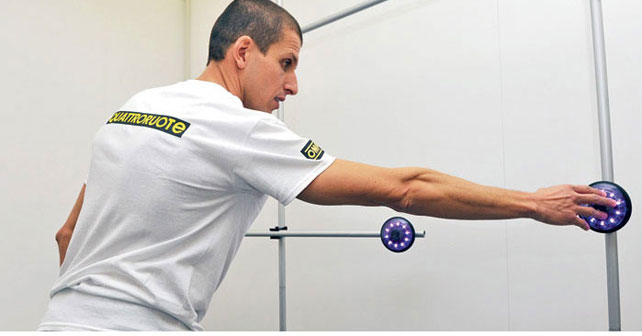
Pictured above, our test driver taking on the Fitlight, which is basically a set of lights that turn on in rapid sequence and at different points. It’s used to evaluate reaction time
The specialist’s opinion 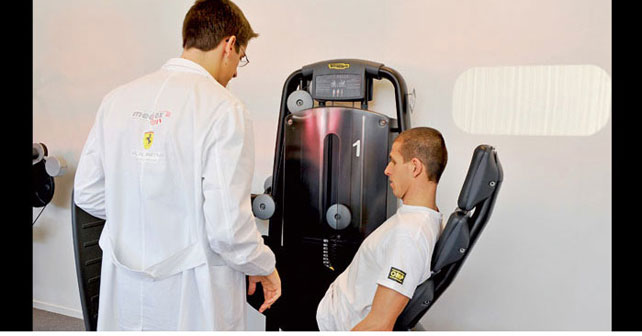
YOUR FOUNDATION IS SOUND, BUT FOR F1...
“Your driver is in excellent condition,” says Alessandro Biffi – who, along with his colleague Fred Ferdinand, manages Med-Ex, a sports physician association specialising in check-ups and prevention. It’s also responsible for the health insurance provided by Ferrari. “Your body is able to produce over 300W; we are beyond 4 Watts/kg, which is already excellent. Your eyesight is also great, reaction time during the light variation exercises was exceptional. Even the neurological reactivity is unusually good – you finished the Fitlight test in 40 seconds, while normal individuals usually take around 60 seconds to finish and the absolute best approximately 30.” In other words, you’re saying that I lack nothing compared to an F1 driver? “Well, we would have to analyse your resistance to fatigue, especially in conditions affected by dehydration. And in terms of muscles, we would need to conduct in-depth training sessions for your neck muscles and lumbosacral area. For this we would need to conduct further tests – but the physical aptitude is there, as is the athletic condition. You have a good base, in other words.”
Load on the head and neck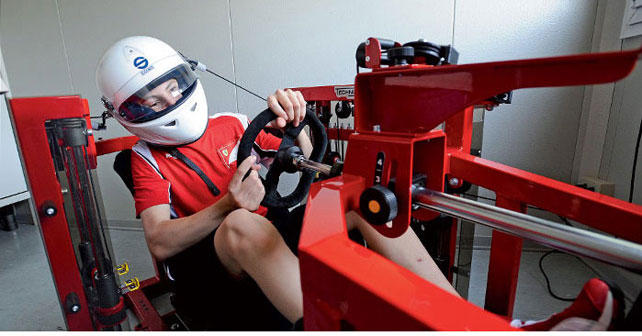
On the left, simulating loads experienced when driving. Note, the weights on the helmet used to reproduce the stress on the head and neck. Above is Ferrari test driver, Jules Bianchi
Mind Room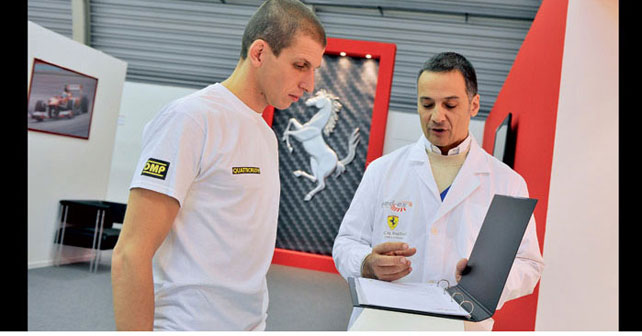
WHERE MENTAL REACTION TIME GETS MEASURED
In many ways, mental training is perhaps more important than the strictly physical. This is why Scuderia Ferrari uses equipment and methodologies developed by Mind Room – a company specialized in psychophysiology, and in related training activities. The Maranello training centre features patented instruments, such as the Mind Chair, which provides Biofeedback; along with the Neuro Tracker, used to train visual attention and peripheral vision. The equipment, and protocols, allow an analysis of not only the driver’s reaction time, but also of his stress-management abilities and recovery skills. An additional analysis is performed on information-processing and, obviously, on the ability to stay focused in extremely critical conditions.
© Riproduzione riservata
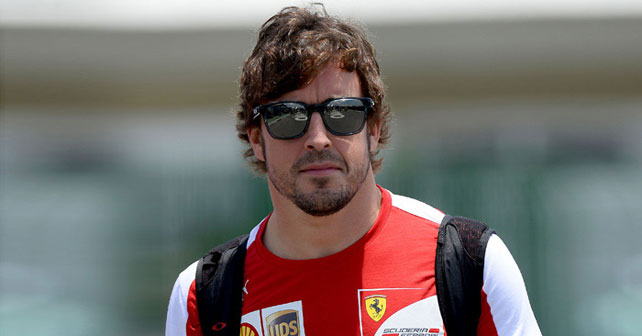

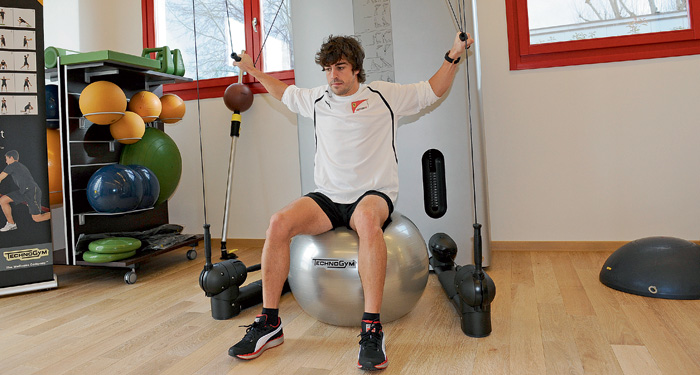
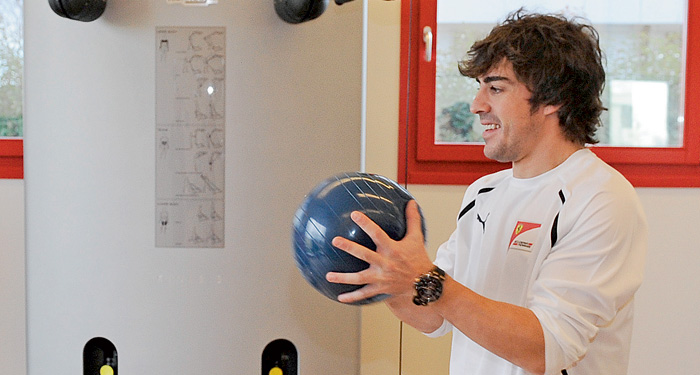
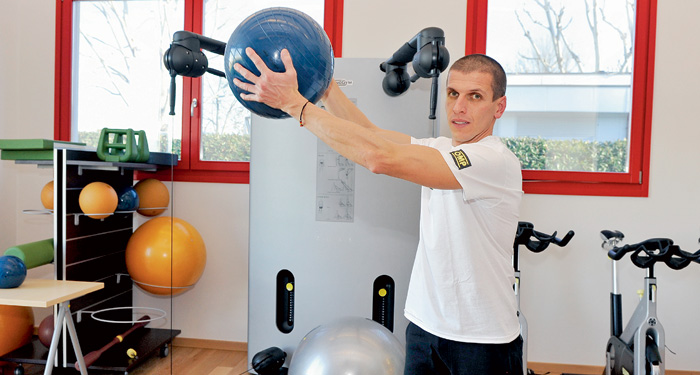
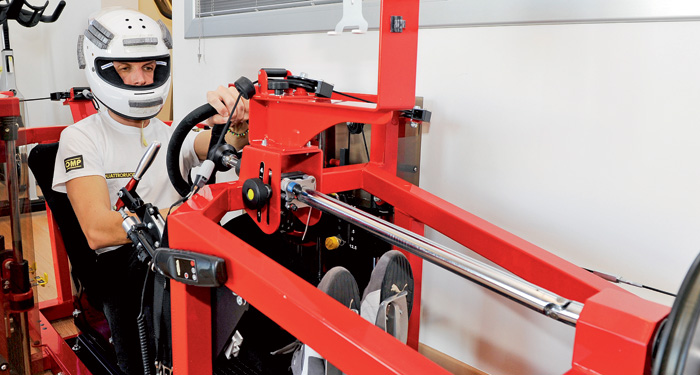

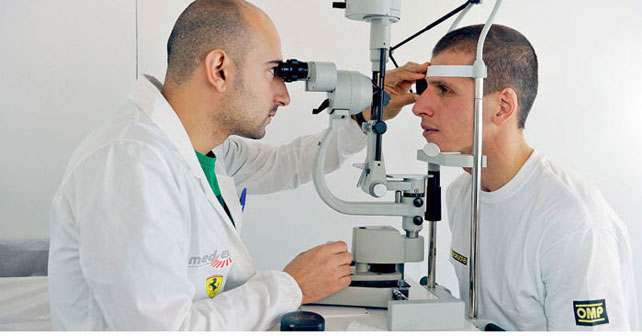
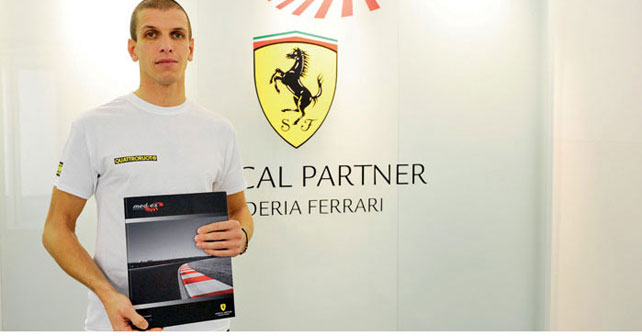
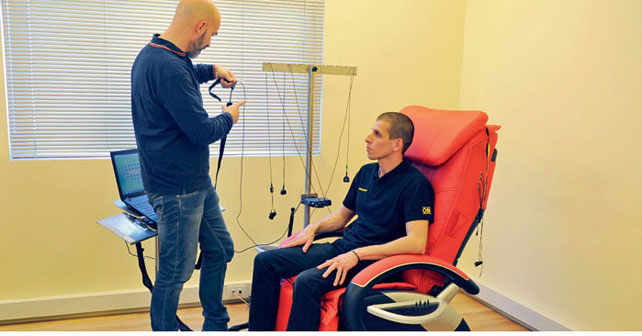
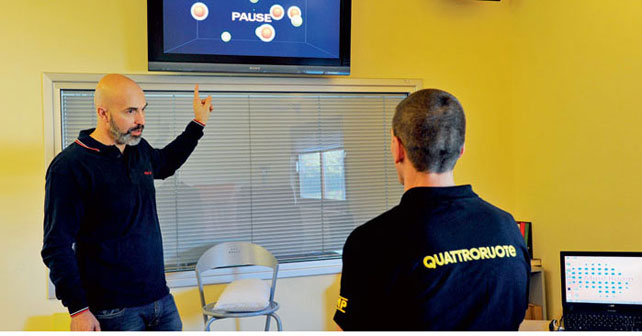









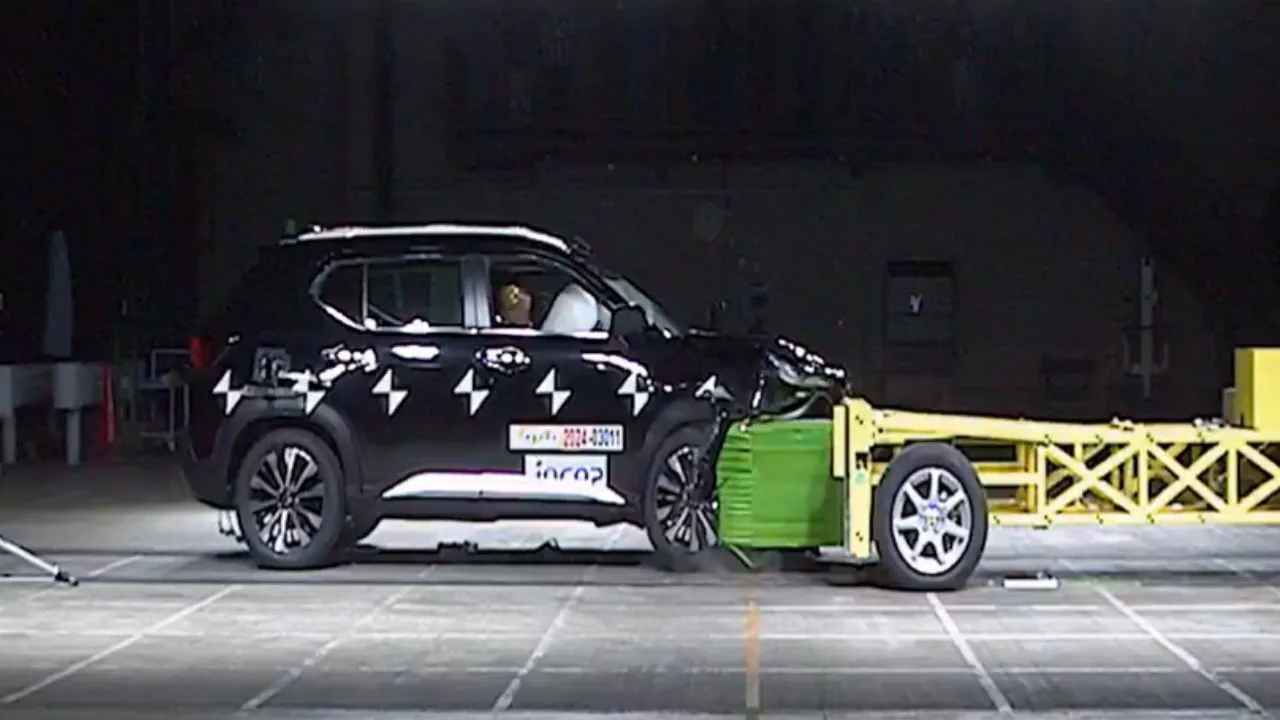
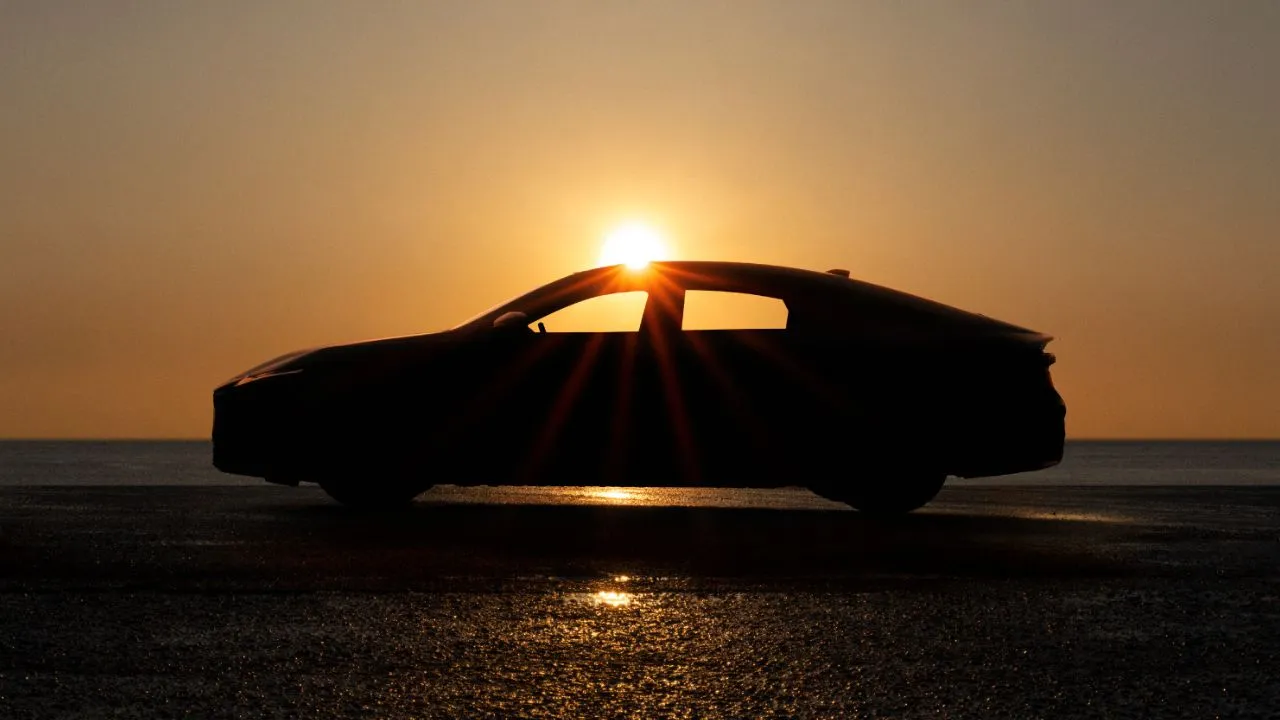





Write your Comment on